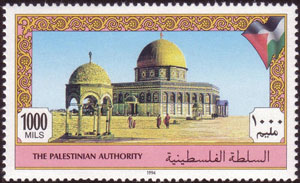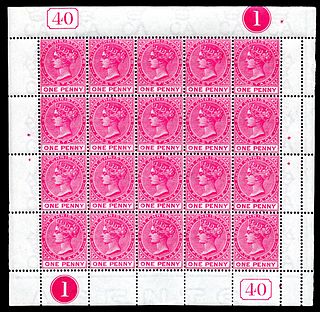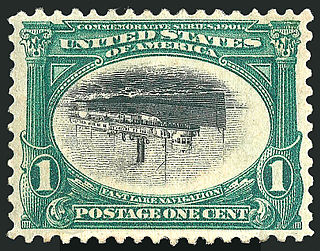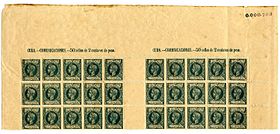
For postage stamps, separation is the means by which individual stamps are made easily detachable from each other.

The Penny Black was the world's first adhesive postage stamp used in a public postal system. It was first issued in the United Kingdom on 1 May 1840 but was not valid for use until 6 May. The stamp features a profile of Queen Victoria.

The Inverted Jenny is a 24 cent United States postage stamp first issued on May 10, 1918, in which the image of the Curtiss JN-4 airplane in the center of the design is printed upside-down; it is one of the most famous errors in American philately. Only one pane of 100 of the invert stamps was ever found, making this error one of the most prized in philately.
This is a list of philatelic topics.

In philately, a block is a group of four or more un-separated stamps. Blocks are of interest not only because they are rarer than individual stamps, but they also preserve relative positions of stamps as they were originally printed, information that is crucial to understanding how the stamps were produced.

A postage stamp booklet is a booklet made up of one or more small panes of postage stamps in a cardboard cover. Booklets are often made from sheets especially printed for this purpose, with a narrow selvage at one side of the booklet pane for binding. From the cutting, the panes are usually imperforate on the edges of the booklet. Smaller and easier to handle than a whole sheet of stamps, in many countries booklets have become a favored way to purchase stamps.

A plate block is a block of stamps from the edge of the sheet which shows the plate or cylinder from which the stamps were printed.

The Machin series of postage stamps was the main definitive stamp series in the United Kingdom for most of the reign of Elizabeth II, from 1967 until her death in 2022. Introduced on 5 June 1967, it was the second series of her reign, replacing the Wilding series. The last issue was on 4 April 2022, four months before the Queen's death on 8 September.

The postage stamps of Ireland are issued by the postal operator of the independent Irish state. Ireland was part of the United Kingdom of Great Britain and Ireland when the world's first postage stamps were issued in 1840. These stamps, and all subsequent British issues, were used throughout Ireland until the new Irish Government assumed power in 1922. Beginning on 17 February 1922, existing British stamps were overprinted with Irish text to provide some definitives until separate Irish issues became available within the new Irish Free State. Following the overprints, a regular series of definitive stamps was produced by the new Department of Posts and Telegraphs, using domestic designs. These definitives were issued on 6 December 1922, the day that the Irish Free State officially came into existence; the first was a 2d stamp, depicting a map of Ireland. Since then new images, and additional values as needed, have produced nine definitive series of different designs.

The postage stamps and postal history of Israel is a survey of the postage stamps issued by the state of Israel, and its postal history, since independence was proclaimed on May 14, 1948. The first postage stamps were issued two days later on May 16, 1948. Pre-1948 postal history is discussed in postage stamps and postal history of Palestine.

The Palestinian National Authority began in 1994 to issue stamps and operate postal services as authorized by the Oslo Accords.

A sheet of stamps or press sheet is a unit of stamps as printed, usually on large sheets of paper based on the size of the printing plate, that are separated into panes that are sold at post offices. Where more than one pane is on a printed sheet they are arranged in a table-like arrangement. The spaces between the single stamps are all of the same size and provide space for a cut or perforation.

As part of the Pan-American Exposition held in Buffalo in 1901 the United States Post Office Department issued a series of six commemorative stamps. Each stamp featured an ornate colored frame enclosing a black-and-white image of some means of modern rapid transportation. In the standard American Scott catalog, these six stamps carry the numbers 294-299. The first day of issue for the stamps was May 1, 1901.
Between 1851 and 1860, the Grand Duchy of Tuscany, an independent Italian state until 1859 when it joined the United Provinces of Central Italy, produced two postage stamp issues which are among the most prized classic stamp issues of the world, and include the most valuable Italian stamp.

A plate number is a number printed in the margin of a sheet or roll of postage stamps, or on the stamp itself, which shows the printing plate used to print the stamps.
A plate number is the serial number of a printing plate. It is printed in the selvage or border of a pane of postage stamps.

Se-tenant stamps or labels are printed from the same plate and sheet and adjoin one another, unsevered in a strip or block. They differ from each other by design, color, denomination or overprint. They may have a continuous design. The word "se-tenant" translates from French as meaning "joined together" or "holding together".

The Halfpenny Yellow is the first postage stamp issued by the Crown Colony of Malta. Depicting Queen Victoria, it was only valid for local postage and it was originally issued on 1 December 1860. It was the only stamp issued by Malta for two and a half decades, and during this period various reprints were made with differences in colour shade, perforation and watermark. When control of Malta's postal service was transferred to the island's colonial government on 1 January 1885, the stamp was withdrawn and it was replaced by a set of definitive stamps.

The U.S. Parcel Post stamps of 1912–13 were the first such stamps issued by the U.S. Post Office Department and consisted of twelve denominations to pay the postage on parcels weighing 16 ounces and more, with each denomination printed in the same color of "carmine-rose". Their border design was similar while each denomination of stamp bore its own distinctive image in the center (vignette). Unlike regular postage items, whose rates were determined by weight in ounces, Parcel Post rates were determined and measured by increments in pounds. The new stamps were soon widely used by industry, farmers and others who lived in rural areas. Partly owing to some confusion involving their usage, their exclusive use as Parcel Post stamps proved short lived, as regular postage stamps were soon allowed to be used to pay parcel postage rates.

In philately, label or coupon or tab is a part of sheet of stamps separated from them with perforation. It cannot be used for postage because it does not have face value and any indication of a postal administration that issued such stamps with labels. The notion of label should not be confused with the term "gutter" or with a margin of a stamp sheet.

















